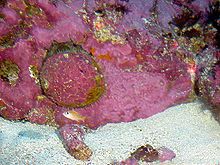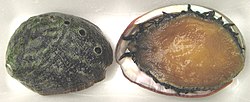Haliotis sorenseni
| Haliotis sorenseni | |
|---|---|

| |
| A live individual of Haliotis sorenseni, left of center. The shell and the rock are covered with red coralline algae. | |
| Scientific classification | |
| Domain: | Eukaryota |
| Kingdom: | Animalia |
| Phylum: | Mollusca |
| Class: | Gastropoda |
| Subclass: | Vetigastropoda |
| Order: | Lepetellida |
| Superfamily: | Haliotoidea |
| Family: | Haliotidae |
| Genus: | Haliotis |
| Species: | H. sorenseni
|
| Binomial name | |
| Haliotis sorenseni Bartsch, 1940
| |
The white abalone,
The white abalone is an endangered species in the United States; it may now have the smallest population of all eight of the abalone species on the west coast of North America.
Distribution

Historically the white abalone ranged from Point Conception, California to Baja California, Mexico, and was found especially on the offshore islands.[3]
In the most northerly part of the
It remains unknown whether this distribution pattern was a result of lack of suitable habitat along the mainland coast in the mid portion of the range, or was instead due to overfishing in these more accessible mainland regions.[3]
Since the mid-1990s, extremely low numbers of isolated survivors have been identified along the mainland coast in
No recent information on current range is available for Baja California. The white abalone population in Mexico is thought to be depleted based on commercial fishery data, but the status of the species in Mexico remains largely unknown.[3]
Description

Shell
The white abalone usually has between 3-5 open holes (respiratory pores) in its shell. These holes collectively make up what is known as the selenizone which form as the shell grows. The shell is oval-shaped, very thin and deep. White abalone can grow to about 10 in (25 cm), but are usually 5–8 in (13–20 cm).[3]
Anatomy
The epipodial tentacles are lacy, beige and yellow-green in color. The bottom of its foot is orange, and the epipodium (a sensory structure and extension of the foot that bears tentacles) is a mottled orange tan.[3]
Ecology
Habitat
The white abalone is the deepest dwelling of eight species of California abalones, living at depths from 80 to 200 ft (24–61 m).[3] White abalone are found in open low and high relief rock or boulder habitat that is interspersed with sand channels. Sand channels may be important for the movement and concentration of drift
Feeding habits
The white abalone is known to be a
Life cycle
Like many gastropods, white abalone have a complex

open squares - commercial catch per unit effort
left y axis - thousands of pounds of shell per vessel
filled circles - price of Haliotis sorenseni
right y axis - US$ per pound.
Human use
Scripps Institution of Oceanography biologists conducted surveys of white abalone deep water habitat in the early 1970s, finding high concentrations of about one white abalone per square yard. Such densities were comparable to abundance of shallower species of abalone found in previously unfished or protected areas. Unfortunately, the high demand for the species led to a "boom-and-bust" fishery, which decimated the populations of this species in seven years.
Considered a
References
- Sources
- This article incorporates public domain text (a
- Team Spawns Rare White Abalone
- White Abalone - An Extinct Possibility?
- Notes
- doi:10.2305/IUCN.UK.2021-1.RLTS.T78771696A78772593.en.)
{{cite journal}}: CS1 maint: multiple names: authors list (link - ^ Rosenberg, G. (2014). Haliotis sorenseni. Accessed through: World Register of Marine Species at http://www.marinespecies.org/aphia.php?p=taxdetails&id=445362 on 2014-10-29
- ^ a b c d e f g h i j k l m "NOAA Fisheries - White Abalone (Haliotis sorenseni)". National Oceanic and Atmospheric Administration (USA). 5 May 2017. Retrieved 2009-10-21.
- OCLC 6907956712.
- ^
- ^ Mason, Dave (2021-09-15). "Learning first-hand about conservation". Santa Barbara News-Press. Retrieved 2022-01-08.
External links
- "Race To Save the White Abalone" video links (NOAA Southwest Fisheries Science Center)
- White Abalone Research (NOAA Southwest Fisheries Science Center)
- National Marine Fisheries Service. (October 2008). "White Abalone Recovery Plan (Haliotis sorenseni)". National Marine Fisheries Service, Long Beach, CA. PDF
- "Hope for the White Abalone" (2004)
- Sonoma County Abalone Network
- "Haliotis (Haliotis) sorenseni". Gastropods.com. Retrieved 16 January 2019.

